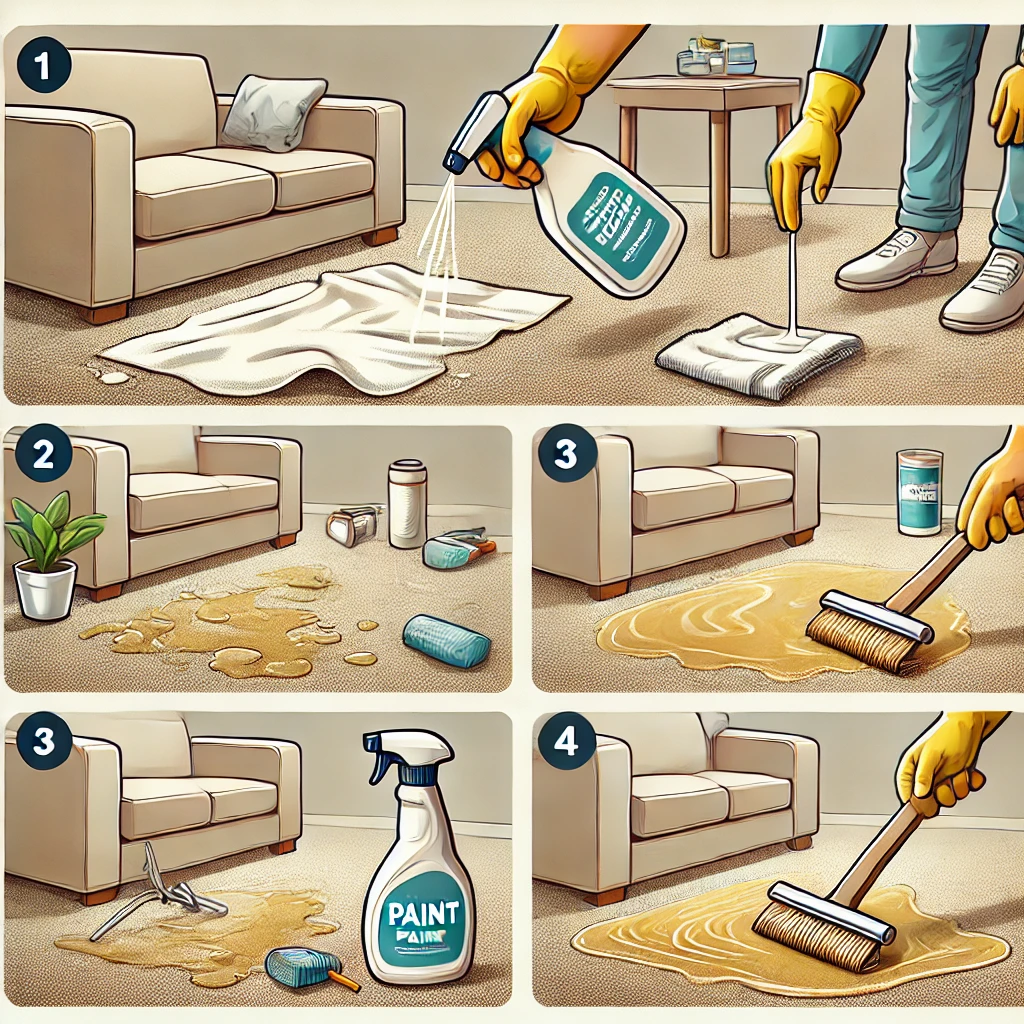
Paint spills on a carpet can be a homeowner’s nightmare, but knowing the right steps can save the day. Acting quickly is crucial because the longer paint sits on a carpet, the harder it becomes to remove. Fresh paint is much easier to clean, as it hasn’t yet seeped deep into the fibers or dried to form a stubborn stain. Whether you’re dealing with a small drop or a large spill, swift action can often mean the difference between a completely clean carpet and a permanent mark.
Understanding the type of paint involved is equally important. Different paints have different compositions, and their removal requires tailored approaches. Water-based paints, such as latex or acrylic, are generally easier to clean as they dissolve in water and respond well to mild cleaning agents. On the other hand, oil-based paints are more challenging, as they require specific solvents to break down the oil content. Acrylic paint, though water-based, can harden quickly and pose unique challenges once dried.
By recognizing the importance of immediate action and familiarizing yourself with the characteristics of different paints, you can effectively address spills and protect your carpet. This guide will walk you through the specific steps and techniques for each type of paint, ensuring that your carpet stays as good as new.
Assessing the Situation
Before you start cleaning, it’s essential to assess the situation carefully. The first step is identifying the type of paint involved. Paint generally falls into three categories: water-based, oil-based, and acrylic. Water-based paints, including latex, are the most common for home use and are typically easier to clean. Oil-based paints, used for durability and a smooth finish, are trickier to remove as they require specific solvents. Acrylic paints are fast-drying and versatile but can harden into a plastic-like state, making removal more challenging if left to dry.
Once you’ve determined the type of paint, evaluate the extent of the spill. A small droplet requires different handling than a large puddle. Note whether the paint is fresh or dried, as this will significantly influence the cleaning method. For large spills, prioritize containing the spread of paint by gently blotting the edges to prevent it from seeping further into the carpet fibers.
General Preparation
Proper preparation is key to successfully removing paint without causing further damage to your carpet. Gather the necessary tools and materials before you start. Essential items include:
- Clean white clothes or paper towels.
- Mild dish detergent or carpet cleaner.
- Solvents like turpentine or mineral spirits for oil-based paint.
- Warm water and a spray bottle.
- A dull knife or scraper for removing dried paint.
Safety precautions are equally important, especially when using chemical solvents. Work in a well-ventilated area to avoid inhaling fumes, and wear gloves to protect your hands. Always test cleaning solutions on a small, inconspicuous area of the carpet first to ensure they won’t cause discoloration or damage.
Removing Water-Based Paint
Fresh Spills
- Blot the paint gently with a clean, dry cloth to absorb excess liquid. Avoid rubbing, as this can push the paint deeper into the fibers.
- Mix a solution of warm water and a few drops of mild dish detergent.
- Dip a clean cloth into the solution and blot the stain, working from the outside in to prevent spreading.
- Continue blotting until the paint lifts from the carpet.
Dried Paint
- Use a dull knife or scraper to gently loosen and remove dried paint from the surface.
- Vacuum the area to pick up any loose paint flakes.
- Apply a mixture of warm water and detergent to the stain, allowing it to soak for a few minutes.
- Blot with a clean cloth, repeating as needed until the stain is gone.
Removing Oil-Based Paint
Oil-based paint requires a different approach due to its resistance to water.
- Blot the spill with a clean cloth to remove as much paint as possible.
- Apply a small amount of a solvent like turpentine or mineral spirits to a cloth.
- Gently dab the stain, avoiding oversaturation that could damage the carpet backing.
- Once the paint begins to lift, clean the area with warm water and mild detergent to remove any remaining solvent residue.
- Rinse with clean water and blot dry.
Pro Tip: Avoid scrubbing, as this can damage the carpet fibers or spread the paint further.
Removing Acrylic Paint
Acrylic paint is water-based but dries quickly, making prompt action critical.
Fresh Spills
- Blot the spill immediately with a clean cloth to soak up excess paint.
- Spray the area lightly with warm water and blot again.
- Use a mild detergent solution to remove the remaining stain.
Dried Paint
- Gently scrape off dried paint with a dull knife or scraper.
- Soften the residue by applying a small amount of rubbing alcohol or a specific acrylic paint remover.
- Blot with a damp cloth until the stain is gone, then rinse with clean water.
General Cleaning Tips
- Test First: Always test any cleaning agent on a hidden area of the carpet to ensure compatibility.
- Blot, Don’t Rub: Blotting is gentler and prevents the stain from spreading or embedding deeper.
- Use White Cloths: Colored cloths may bleed dye onto the carpet, complicating the cleanup.
Handling Stubborn Stains
If the paint stain persists after several attempts, consider advanced cleaning methods:
- Use a steam cleaner to loosen dried paint.
- Apply a commercial carpet stain remover designed for tough stains.
For severe cases, professional carpet cleaning services may be necessary. They have specialized tools and expertise to remove even the most stubborn stains.
Preventive Measures for Future Spills
To avoid future paint spills, take precautions during painting projects:
- Lay down drop cloths or plastic sheets to protect carpets.
- Keep paint containers sealed when not in use.
- Act immediately if a spill occurs to minimize damage.
Read more: How to Remove Water Stains From Fabric, Walls, and Carpet
Conclusion
Removing paint from a carpet can seem daunting, but with the right approach, it’s manageable. By identifying the type of paint, acting quickly, and following appropriate cleaning techniques, you can effectively tackle spills without damaging your carpet. Remember, preparation and patience are key to restoring your carpet to its original state.
